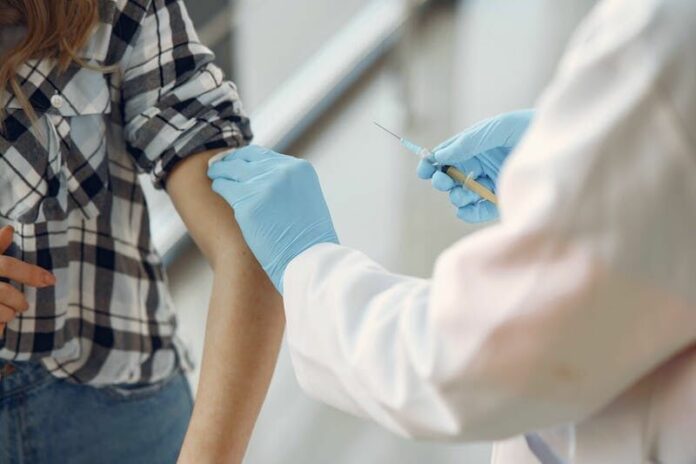Sonoma County Health Officer Dr. Sundari Mase began the Jan. 6 community briefing on the COVID-19 vaccine rollout with the county’s newest numbers, joined by 5th District Supervisor and board chair Lynda Hopkins, Dr. Kismet Baldwin and other local public health officials on a panel.
Sonoma County’s stay-at-home order expires at 11:59 p.m., Jan. 9, but the county will remain similarly shut down under the Bay Area’s stay-at-home-order imposed by the state because the region’s intensive care unit capacity is below 15%, Mase said.
“Right now, as of Jan. 5, we have 102 COVID-confirmed cases who are hospitalized at this time, the most in the last week that we’ve ever had,” Mase said, referring to Sonoma County’s numbers. “We had been at a very low ICU capacity until our hospitals recognized that they needed to add staffed ICU beds.”
Hospitalizations have been increasing since mid-November and local hospital efforts boosted the county to its current 25.6% capacity, compared to the Bay Area’s 7.4% as a whole, she said.
According to Mase, the county administers over 3,000 COVID-19 tests a day, at a volume nearly twice the state average with 676 tests per 100,000 residents a day compared to the state average of 362 per 100,000 people. The county’s virus testing data portal hasn’t been updated since Dec. 30, but its primary virus data portal shows that over 5,000 tests have been administered in the past 24 hours.
Mase said the state uses a factor of .57 to adjust for the additional testing in the county’s case rate, so the county’s unadjusted case rate is about 38 new daily cases per 100,000 and its adjusted rate is about 35.
“It’s about three to four times what our rate has been about six weeks ago,” Mase said. The county bears a 7.8% overall testing positivity, her presentation said.
The arrival of the COVID-19 vaccines on Dec. 17 marked a milestone in containing the widespread transmission in the area. Mase said the county has received about 17,500 doses of Pfizer and Moderna vaccines and over 8,000 residents received their first dose of the two-part vaccine so far.
“We’ve had the vaccine for about three weeks and have been distributing and implementing the vaccine very successfully for the past two and a half weeks,” Mase said.
The state ships vaccines to the county public health department to distribute to its multi-county hospitals — Sutter Santa Rosa Regional Hospital, Kaiser Permanente and Santa Rosa Memorial — and directly to CVS and Walgreens pharmacies tasked with vaccinating skilled nursing and residential care facilities, she said.
Paul Gullixson, county communications manager, said residents can go to socoemergency.org’s vaccine page for information on eligibility and prioritization for vaccination. Mase said the county plans to notify groups as they qualify in other ways, as well.
Baldwin said residents are not required to show proof of eligibility, like work or personal identification to get vaccinated because the county does not want identification to be a barrier to the service.
“If you provide some sort of proof, that’s great. And if you can’t, we’re going to take your word on that and we’ll administer the vaccine to you,” she said.
Vaccine rollout by tiers and phases
According to Mase, about two-thirds of the county’s vaccines have been administered in the first distribution phase, three-tiered Phase 1a, which prioritizes healthcare personnel, residents and staff in long-term care facilities.
The health officer said Tier 1 of Phase 1a is almost complete and the county is collaborating with different entities to vaccinate everyone eligible at this time.
The county began Tier 2 on Jan. 4 to vaccinate workers in federally qualified health centers, primary care, in-home support services, correctional health, behavioral health and urgent care clinics. Public health field staff, community health workers and promotoras are also eligible under Tier 2, Mase said.
Mase predicted Tier 3 to begin mid-January for vaccinating specialty clinic staff, dentists and other oral health workers, morticians, medical examiners, pharmacists and lab workers. Some partners include the Sonoma County Medical Association, the Disaster Emergency Management Agency and EMS and paramedic groups licensed to vaccinate.
In addition to the pop-up vaccination clinics that may appear at fire stations and elsewhere run by licensed EMS and paramedic groups, the county is partnering with local Safeways registering to administer vaccines to some Tier 3-eligible groups, she said.
Around the end of January, two-tiered Phase 1b will see the vaccination of residents 75 years old and older, frontline essential workers, adults ages 65 to 74 years old with underlying medical conditions, incarcerated individuals, homeless individuals and transportation and critical manufacturing workers, according to Mase’s presentation. She mentioned agricultural workers and educators would also become eligible.
Phase 1c of the distribution process qualifies all adults 65 to 74 years old and those ages 16 to 64 years old with underlying medical conditions or disabilities and other essential workers, including those in water and waste management, IT, communication and government operations, Mase continued.
Finally, everyone else 16 years-old or older in the U.S. becomes eligible for the vaccine when Phase 2 is expected to start in spring 2021, according to Mase’s presentation. The health officer said vaccine studies focused on people 16 and older, so recommendations on vaccinating youth younger than that will follow emerging data on that age group.
According to Mase, how quickly Sonoma County advances through the phases and tiers depends on how many vaccines the state allocates to the county, based on its own vaccine supply and how many people want to be vaccinated in the different groups.
Hospital representatives and other public health officials on the rollout
A panel of local medical leaders weighed in on vaccine distribution, answering questions from Hopkins, media and the public as moderated by Gullixson.
Dr. Chad Krilich, the chief medical officer for Santa Rosa Memorial Hospital and Petaluma Valley Hospital, said his organization has administered over half of 5,000 doses of Moderna and Pfizer vaccines and is starting to administer the second dose of the two-part vaccine this week.
He said COVID-19 vaccinations differ from the usual flu shots because hospitals need to prioritize who receives the vaccine, so his hospitals have been surveying healthcare personnel eligible in Phase 1a to identify who works in the COVID-19 unit, their level of exposure and interest in the vaccine to then schedule appointments.
Krilich said he expects his hospitals to reach Phase 1b by the end of January. The hospitals will partner with St. Joseph Health Medical Group to coordinate texts and emails to assess where they fall under 1b to schedule vaccinations accordingly.
Likewise, Dr. Michael Shulman, Kaiser Permanente Physician in Chief, said the hospital has organized its health care workers with a risk-based stratification algorithm to vaccinate the most at-risk workers first.
Shulman said the hospital is almost 80% complete with vaccinating its employees and physicians and would prepare to administer their second doses of Moderna and Pfizer this week, also looking forward to Phase 1b in alignment with the county and California Department of Public Health timeline.
“I think one of the key takeaways that I’d like to share is that we were anticipating a lot of people coming and reporting side effects from vaccines,” he said. “And I think the number one side effect I’d like to report is a sense of relief, hope and gratitude for our ability to rapidly and efficiently and effectively roll out a vaccination effort.”
Hopkins introduced Jason Cunningham, CEO of West County Health Centers, as a leader among health care providers collaborating on public communication of the vaccine plan. He expressed his excitement for the vaccine but said “People have concerns and I also recognize that different communities have a different experience of vaccinations and large-scale vaccinations. And they have different experiences with trust and public health and our government.”
Cunningham said Kaiser, Sutter, West County Health Centers and the county’s public health department will be more effective if they unify their messaging around vaccine safety and meet communities where they’re at in language, culture and perspective.
“If you think about the lens of equity from, is everybody going to have access? Is there going to be issues with delivery towards certain populations? So coming together, I think we’ll all look back on this time to say this was one of those times, if we do this well, that we are going to have a big impact on the health and safety of our community, but only if we do that together.”
Carly Sullivan, Advanced Life Support Coordinator for Coastal Valleys EMS Agency, said the organization was approved by the California Emergency Medical Services Authority to use its paramedics and EMTS to do swabbing, testing, antibody blood draws and vaccinations.
“We will continue to explore ways to use our EMTs and paramedics locally to support any vaccination efforts,” she said, adding its paramedics and fire departments vaccinated all of the agency’s EMS and fire medical responders last week.
Hopkins said having local medical personnel approved by the state to participate in a mass vaccination campaign demonstrates the county’s ability to create surge capacity.









